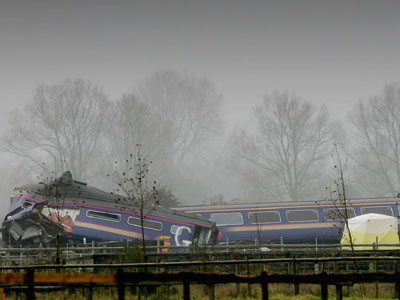Indholdsfortegnelse
Jernbaneulykken ved Ufton Nervet den 6. november 2004 kostede 7 mennesker livet.
Den 6. november 2004 kl 18:12 GMT kolliderede 17:35 First Great Western fra London Paddington, med 43019 forrest og 43029 bagest, til Plymouth med en holdende bil med føreren i, i en automatisk sikret overkørsel nær Berkshire landsbyen Ufton Nervet. 
The rear of the 220 m-long HST set came to rest approximately 100 m beyond the crossing with all eight passenger carriages derailing. Six people were killed in the crash, including the car's driver, the driver of the train, and four of its passengers. Another passenger subsequently died in a hospital, resulting in a total of seven fatalities. Approximately 300 people were on board at the time of the incident(exact numbers are unknown but official estimates are around 180-200), with around half of these injured, including twelve serious injuries. Eleven people had to be cut free from the wreckage. Once again, the high structural integrity of the Mark 3 coaches prevented a much higher death toll.
The accident, investigation and necessary repairs blocked the main railway route between London and the West Country until the morning of 16 November, subsequently operating under temporary speed restrictions to allow the bedding in of ballast. In the meantime inter-city trains operated via Swindon and Westbury and local services were replaced by rail and bus shuttles. In mid 2005, 43019 was scrapped and 43029 was given back to Angel Trains after FGW stored the loco following the accident.
Background
I Storbritanien, anvendes automatiske ½-bomanlæg ved overkørsler på svagt trafikerede veje hvor strækningshastigheden ikke overstiger 160 km/t. These are unmonitored and are designed so that a car cannot get accidentally trapped behind a forward barrier. This also allows a person to attempt to „zig zag“ around the barriers onto the track, usually in an attempt to save time. On busier roads, bridges or tunnels are preferred, or where this would be prohibitively expensive, a full-barrier crossing is built. These are always monitored, by CCTV or less often in person, and the facing barriers are only closed once all vehicles have cleared the line.
Investigation
An investigation has begun, carried out by Thames Valley Police and the British Transport Police. A preliminary report by the Health and Safety Executive indicated that the car stopped on the level crossing prior to any warnings, and failed to react to the barrier alarm sequence. A minor deflection of the stationary car to one side by the train derailed the forward bogie, which continued to travel at about 25° to the rails until reaching points at the start of a loop. The power car at this point fully derailed, causing the remainder of the train to also slip the points.
In the absence of information from the investigation, local and press speculation centred on the theory that Bryan Drysdale, the car's driver, may have parked on the level crossing in order to commit suicide, because there is no evidence of any attempt to move or exit the car.
The preliminary report of the Rail Safety and Standards Board published on 1 February 2005 reports among its findings so far that: *the automatic half-barrier equipment and its associated ancillary equipment is in good condition and properly maintained. *the driver shut off power and coasted for around four seconds, which was normal for this point in the journey. He then made an emergency brake application at or about the time of impact with the car. *lighting was completely lost in all the coaches during the accident. As a result, passengers and crew found orientation difficult, though the provision of snap light wands alleviated this problem to some degree. Some passengers who attempted to break windows in order to escape from the vehicle were hampered by breakage of the window hammers, and by the difficulty of reaching the upper windows of a vehicle leaning heavily to one side. *no evidence that the maintenance condition of the train contributed in any way to the derailment or exacerbated its consequences. *no evidence has been presented to the inquiry that would indicate there were any deficiencies in the fitness for duty on the part of the staff of either Network Rail or First Great Western.
On 1 June 2005 it was announced that an inquest into the crash would be held at the Guildhall in Windsor. The inquest was expected to last 12 days, starting on 17 October 2005. It has now been delayed due to a row over whether the families of the victims should receive legal aid.
The Ufton Nervet Train Crash Network was set up by survivors, bereaved, relatives and others affected by the Ufton Nervet Crash to share information, self-help tips and ideas. They also arrange anniversary events on site and 'down the line' in Exeter. It is open to anyone and is free, independent and confidential. It is not a campaigning group but those wishing to do so are supported. On-going issues include the delayed Inquest, requests for Legal Aid, train safety, compensation and provision of report. Anyone affected by this and other rail crashes and any other traumatic incident may benefit from the Network website ww.untc.co.uk or call the Co-ordinator 01635 30644
List of the deceased
- Charlie Matthews, 72, of Warminster, Wiltshire
- Emily Webster, 14, of Moretonhampstead, Devon
Overkørslen
Ulykken skete i en overkørsel på en smal vej, der forbinder landsbyen Ufton Nervet med hovedvej A4, ca 300 m fra vejen tilslutning til hovedvejen. Overkørslen ligger mellem stationerne Theale og Aldermaston.
See også
- Glendale train crash - a January 2005 crash on the Los Angeles, California, commuter rail system with similar circumstances.
References
- 'Several' die in train derailment - BBC News
- BBC reporter eyewitness report - BBC News
- Seven train crash dead are named - BBC News
- Inquest into Ufton Nervet crash - BBC News